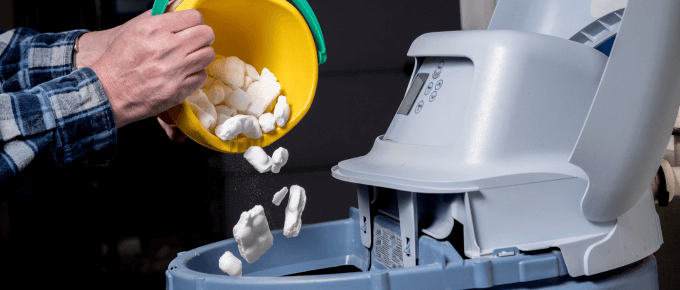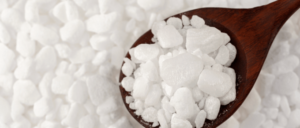How much salt in water softener?Have you ever looked at the brine tank of your water softener and questioned whether you added enough salt? Or you’ve dealt with the aggravation of having hard water problems due to a salt bridge obstructing your softening system. Alright, stop worrying, fellow soft water seeker! To ensure your water stays as smooth and scalp-friendly as ever, we’re on a mission to solve the mystery of water softener salt levels.
Imagine a world in which hard water buildup has been removed from your appliances, your skin feels as soft as a baby’s, and your hair shines with renewed health. This is the world of ideal salt levels for water softeners, my friend—a place where worries about hard water become a thing of the past.
However, let’s tackle the big issue before getting into the specifics of salt intake: how much salt is in water softener? Ion exchange is a miraculous mechanism that holds the key to the solution. The resin beads in your water softener work like tiny magnets, drawing in and holding on to the hard water minerals that cause problems for your plumbing. The unsung hero of this process, salt, renews these resin beads so they’re always prepared to face up against the unrelenting attack of hard water.
And now for the subject that has bothered every homeowner: how much salt is too much? Do not be alarmed; we will solve this riddle. To guarantee a consistent salt supply for regeneration, your brine tank should be at least 25% full. However, avoid overfilling because too much salt might cause brine tank overflow and potential corrosion difficulties.
So, how frequently should you check your salt levels? A simple monthly check is sufficient, but you may need to check more regularly if you have a particularly large household or live in a location with exceptionally hard water.
How Do You Calculate Salt for a Water Softener?
Navigating the complexities of salt usage for water softeners can be difficult. However, you can quickly calculate the optimal salt usage for your water softener using a simple formula and a few essential considerations.
Factors Influencing Salt Consumption
Before getting into the calculation, it’s important to understand the variables that influence salt usage in water softeners:
- Water Hardness: The harder the water, the more salt is needed to remove calcium and magnesium ions properly.
- Water Consumption: The more water you drink, the more salt you eat.
- Water Softener Efficiency: Older or less efficient water softeners may use more salt than newer models.
Calculating Salt Requirements
Let us now provide the formula for determining the optimal salt usage for your water softener:
Salt Consumption (lbs/day) = (Water Hardness (grains/gallon) x Daily Water Usage (gallons) x 0.17) / Salt Exchange Efficiency (grains/lb)
For example, if your water hardness is 10 grains per gallon, your daily water use is 100 gallons, and the salt exchange efficiency is 20,000 grains per pound, your salt consumption would be:
Salt consumption (lbs/day) = (10 grains/gallon x 100 gallons x 0.17) / 20,000 grains/lb = 0.85 lbs/day
Interpreting the Results
The computed salt intake shows your water softener’s recommended daily salt demand. Remember to adjust the salt level in your brine tank to maintain optimal performance as needed.
Can You Overfill a Water Softener with Salt?
While having enough salt is essential for water softener performance, too much salt can have negative implications. Overfilling your water softener might reduce its performance and lead to harm.
Signs of Salt Overload
The following are some clear signs that there might be too much salt in your water softener:
- Water with an Overly Salted flavour: If the taste of salt permeates your water, there is probably too much salt in the brine tank.
- Limescale Buildup: If you see deposits of limescale on faucets, fixtures, or within appliances, even with routine salt replenishment, it may be an indication that your water softener is not eliminating hardness well enough, potentially because of an overabundance of salt.
- Overflowing Brine Tank: You’ve obviously put too much salt in your brine tank if it consistently overflows.
Potential Consequences
Filling your water softener too full might cause several problems.
- Reduced Efficiency: An overabundance of salt might block your water softener’s resin bed, making it less efficient in eliminating hardness.
- Corrosion: Metal parts in your water softener and plumbing system can be eroded by too salty water.
- Wasteful Salt Use: When you overfill, you use more salt than is necessary, which raises the running costs of your water softener.
Prevention and Recommendations
The following recommendations can help you avoid overfilling your water softener:
- Use the Recommended Salt Level: To find the recommended salt level for your particular model, refer to the owner’s manual or contact the manufacturer of your water softener.
- Check Salt Levels Regularly: Monitor the salt level in your brine tank regularly and top it off only as needed.
- Avoid Overfilling: Allow space in the brine tank so the water and salt can combine properly. Wait to fill it.
Which Salt is Best for Water Softener?
Choosing the best water softener salt might be difficult because many different kinds are available. Knowing which types of salt are appropriate for your water softener is important for best results.
Types of Water Softener Salt
Salt used as a water softener comes in three main varieties:
- Evaporated Salt: The most popular salt used as a water softener is evaporated salt, which is made by evaporating saltwater. It’s affordable and easily accessible.
- Solar salt is more ecologically beneficial because it is extracted from natural seawater evaporation ponds.
- Potassium Chloride Salt: This salt is a sodium-free substitute for people on a sodium-restricted diet.
Selecting the Ideal Salt
The best water softener salt for your particular needs is determined by various criteria, including:
- Water Hardness: If your water is really hard, you may want a higher-quality salt, such as solar salt, to soften it effectively.
- Model of Water Softener: Check with your water softener.
Sum-up
As we end our action through the depths of water softener salt levels, it’s important to remember that keeping ideal salt levels is an investment in your home’s plumbing, appliances, and overall water quality. Understanding the factors that influence salt consumption, recognizing the signs of salt imbalance, and adhering to the recommended salt levels for your specific water softener will ensure that your water softener continues to work its magic for years to come, providing you with soft, scale-free water.
Keep hard water from setting the quality of your water. Check the salt level in your water softener today to take the first step toward soft, delicious water. When it comes time to replenish, select a high-quality salt compatible with your model. Review your water softener manual or contact the manufacturer if you require additional assistance.
Remember that soft water is an investment in your home, appliances, and well-being. Today, embrace the power of soft water and see the difference it can make.


Leave a Reply